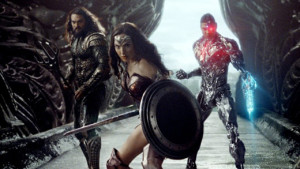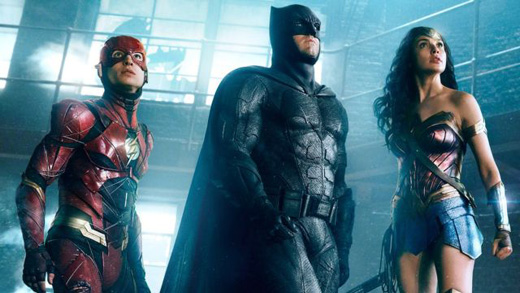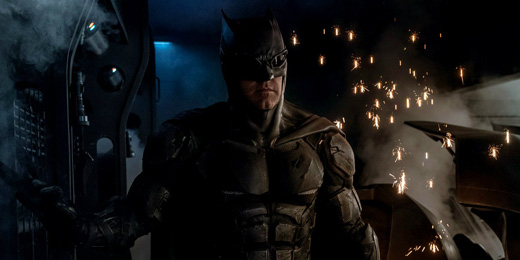Review: Justice League (2017) – A True Ensemble Comic Book Team Film that Gets Its Characters Right.

The long gestating conclusion of DC’s ambitious crossover film plans succeeds in course-correcting the tone of its film universe in the wake of the success of Wonder Woman.
It’s no secret that the Justice League audiences will be watching in theaters on November 17th is not the version that Warner Brothers had hoped it would be. DC was synonymous with great big budget comic book films the last decade riding the wave of the Christopher Nolan “Dark Knight” Trilogy. 2013’s Man of Steel, helmed by Zack Snyder and written by The Dark Knight’s David S. Goyer, relaunched Superman after an abortive attempt in 2006 in the grounded, gritty, dark-toned world-building hues that Nolan’s Batman had successfully emerged from. However, in 2012, Joss Whedon’s The Avengers changed the game of what audiences were expecting from their comic book films; light and quippy ensemble pieces with relatable heroes with feet of clay. The dark, solemn, archetypical heroes of Warner Brothers’ DC films; weighed down with moral ambiguities over their place in the universe and deaths caused by their wake were a harder sell to film audiences in the wake of the success of Deadpool and Guardians of the Galaxy. 2016’s Batman v. Superman: Dawn of Justice made this all the more apparent when its breakout star was Gal Gadot’s Wonder Woman; due to her character’s relatibility and lack of brooding. It’s also well-known that due to a family tragedy, Zack Snyder had to leave the film and Joss Whedon (director of Marvel’s Avengers and Avengers: Age of Ultron) had to step in to write and reshoot extensive amounts of the film. Now, as the film hits moviegoers’ screens, the question arises, does this unique product of two directors with vastly different track records regarding massive tentpole properties manage to work as a film?
The answer is yes. Justice League picks up some amount of time after Batman v. Superman: Dawn of Justice. In the wake of Superman’s demise, criminals have become emboldened in their scope as the population is left in despair following the death of the Man of Steel. Snyder underlines this a little bit on the nose in one of his signature opening montages showing a world not that different from our own, with emboldened neo-nazis attacking an Islamic family and homeless being passed by to the strains of a cover of Leonard Cohen’s “Everybody Knows” as sung by Icelandic pop-star Sigrid. In this solemn world , Batman has taken back to crime-fighting in the streets of Gotham, not so much to scare the new superstitious and cowardly lots of criminals, but to use their fear. In the wake of Superman’s death, alien scouts known as Parademons are prowling the Earth in search of something and Batman realizes these beings are drawn to fear. Affleck’s Batman, one of the shining stars of Snyder’s Batman v. Superman: Dawn of Justice, takes one of these Parademons down and comes to the realization they are searching for 3 cubes of power. Meanwhile, across the world on the Amazonian Isle of Themiscrya, one of these cubes, known as a Mother Box, has awakened and signaled itself to a being known as Steppenwolf, who was once aligned with beings known as New Gods and who has been in exile since failing to capture Earth for his master, Darkseid. Steppenwolf, having been alerted of Superman’s death by Lex Luthor at the end of Batman v. Superman: Dawn of Justice, makes his move to awaken these Mother Boxes and trigger an event called Unity to make the world palatable for his master. Thus, having been alerted to this crisis, Batman and Wonder Woman attempt to gather the other meta-humans they are aware of; Barry Allen (Ezra Miller), Arthur Curry (Jason Momoa) and the Cybertically enhanced Victor Stone (Ray Fisher) to make a stand and defend the Earth against Steppenwolf and his invading horde of Parademons and save the world.
Whedon’s signature is all over Justice League. The plot mechanic of having Steppenwolf collecting the Mother Boxes from Atlantis, Themiscrya, and Metropolis manages to work in the Amazons, introduce the Atlanteans, and give us some backstory on the Mother Boxes from how the one at STAR Labs was discovered and juggle the multiple franchises in an organic way. Ezra Miller’s Barry Allen follows the prototypical excited yet nerdy persona inhabited by Whedon characters from Buffy’s Willow to Firefly’s Wash. Miller steals every scene he is in and the chemistry between Miller’s Flash and Fisher’s Cyborg is one of the highlights of the film. One of the more compelling and refreshing angles on Justice League is that it is no particular characters movie; this is a true ensemble piece. While Gadot’s Wonder Woman and Affleck’s Batman are the breakout stars of Batman v. Superman: Dawn of Justice and both have their respective arcs, they don’t dominate the film’s narrative the way that Robert Downey Jr. dominated the Avengers films or Hugh Jackman’s Logan makes the X-Men franchise essentially Wolverine & Friends. This is Whedon’s 3rd tentpole superhero team franchise film and it feels like he’s got it down this time. The stakes seem real and delineated, each character has their own arc and the chemistry between them is earned by the time they team up. Ben Affleck’s Batman struggles in his role as reluctant leader and having to stop a threat that his aging, broken body cannot possibly stop. Wonder Woman struggles with filling the role of hero and beacon that Superman held in the world and those two plots drive the rest of the character’s interactions forward. Momoa’s charisma and swagger as Aquaman bolds well for his solo film and he’s one of the shining new stars of this piece. The big elephant in the room of Justice League; where is Superman and is he represented in the film, is answered early on and works within the context of the universe this world has built. The way the team comes together in Justice League is much more organic than how Whedon handled it in Avengers and while the film feels like a Whedon film, its definitely taking its lead from the groundwork Snyder laid out for it in earlier films and ties up some loose ends from previous DC films.
While Justice League is definitely worth the watch, it is by no means perfect. The CGI in the film is more than a bit rushed and excessive; Steppenwolf is a fully CG character, voiced by Game of Thrones‘ Ciaran Hinds. There’s no real or even canonical reason for Steppenwolf to be a CG character and his fully CG face does not impress, it really hurts the finished product. Ciaran Hinds’ performance was not a motion captured one and overall it looks like a bad video game render that should’ve been caught sooner. It’s also been noted that Henry Cavill was working on a different film as the same time as Whedon’s reshoots that required he keep his moustache grown for that film during Justice League reshoots. As such, there are various scenes that have Cavill’s face digitally recreated sans mustache that don’t quite pass uncanny valley standards. They aren’t excessive, but the very first scene in the film, while excellent in tone and writing, suffers greatly from this issue. Ray Fisher is excellent as Cyborg and his brooding character growing into confidence is one of the films unexpected upsides; however, his CGI character design is overly Transformer-esque in execution and the rocky metallic texture of his outfits, as well as that of the Parademons and Steppenwolf, suffers from being overly similar to each other. The Parademons themselves are never treated as terrifying or bizarre and are basically as disposable a villain as the Chitauri in Avengers; Whedon knowns enough that introducing alien tech via an invasion scenario is a straight forward way to create plot opportunities for future films and was smart enough to integrate that in this film as well. The macguffin like Mother Boxes drive the film just as much as the Tesseract drives the first Avengers film, to create a sense of urgency and bond the group through adversity; but it would be nice if they also didn’t serve as a deus ex machina multiple times in the film. Whedon is a script doctor and a talented screenwriter, he knows a good script needs certain beats and this film hits them, albeit a little too loudly at times. It also goes without saying that this film completely ignores the existence of Suicide Squad and might be a stronger film had that film not hit on some of the beats that Justice League also hangs its hat on, like the chaos in the wake of Superman’s death. One might argue that it almost doesn’t make sense that a character like Will Smith’s Deadshot isn’t in the film given his character’s arc in Suicide Squad even as a back-up cleaner-esque character.
But for all the dodgy CGI design, the tone of the film is correct. We get actual characters with motivations and personalities and see them interact in ways that entertain and inspire. Danny Elfman’s score also adds to this feeling; one with pomp and circumstance and horns reminiscent of John Williams’ score for Superman – which makes several appearances in the film, as well as Elfman’s own themes from the classic 1989 Batman and 1992’s Batman Returns. This movie gives the DCEU a blank slate to springboard hopeful films in the vein of Wonder Woman. It boasts one of the best mid-credit scenes in recent memory and its post credit scene promises a film that longtime DC fans would be excited to see. But the important thing it gets right is that its a movie that spotlights the characters in a team-up, but shows us these are characters who are stronger together. Steppenwolf is the film’s big bad, but the real stumbling block is these characters overcoming their fears and shortcomings and realizing that as a unit they are better than any could be individually; a lesson that Marvel still stumbles in telling in its team up films. Justice League is probably the beat team-up film since 2014’s Guardians of the Galaxy and infuses the DC universe with some much needed light.





